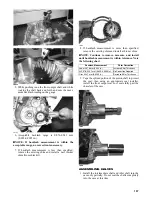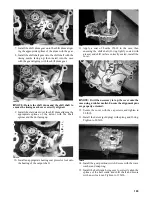
151
PR719C
4. Install the caliper onto the caliper holder making sure
the caliper and holder are correctly oriented.
NOTE: It is very important to apply silicone grease
to the O-rings and caliper bores prior to assembly.
PR239C
5. Making sure brake fluid does not contact the brake
pads, compress the caliper holder toward the caliper
and install the inner brake pad; then install the outer
pad.
PR238
PR239
6. Place the brake caliper assembly into position and
secure with new “patch-lock” cap screws. Tighten
the caliper to 20 ft-lb.
7. Place a new crush washer on each side of the brake
hose fitting and install it on the caliper. Tighten to 20
ft-lb.
8. Fill the reservoir; then bleed the brake system (see
Periodic Maintenance/Tune-Up).
9. Install the wheel; then using a crisscross pattern,
tighten the wheel nuts in 20 ft-lb increments to a
final torque of 40 ft-lb (steel wheel), 60 ft-lb (alumi-
num wheel w/black nuts), or 80 ft-lb (aluminum
wheel w/chrome nuts).
10. Remove the vehicle from the support stand and ver-
ify brake operation.
Master Cylinder Assembly
NOTE: The master cylinder is a non-serviceable
component; it must be replaced as an assembly.
REMOVING
1. Slide a piece of flexible tubing over the front left
brake caliper bleeder valve and direct the other end
into a container. Remove the master cylinder cover;
then open the bleeder valve. Allow the brake fluid to
drain until the reservoir is empty.
2. Remove the cotter pin and pivot pin from the yoke;
then disconnect the two spade connectors from the
switch.
CAUTION
If brake pads become contaminated with brake fluid,
they must be thoroughly cleaned with brake cleaning
solvent or replaced with new pads. Failure to do so will
result in reduced braking and premature brake pad fail-
ure.
! WARNING
Never use brake fluid from an open container or reuse
brake fluid. Moisture-contaminated brake fluid could
cause vapor build-up (expansion) during hard braking
resulting in greatly increased stopping distance or loss
of control leading to injury or death.
















































